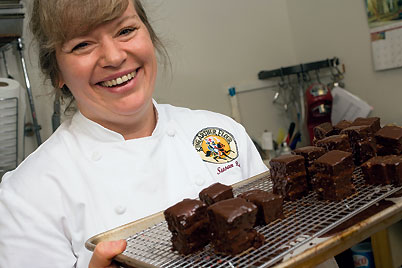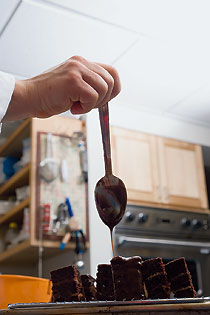Say It with Flour

“Try dealing with five pans of brownies a day,” says Susan Reid ’79 of King Arthur Flour. Photos by Phyllis Graber Jensen
Susan Reid’s cozy nook at King Arthur Flour in Norwich, Vt., sits outside a baker’s dream — a kitchen where the ovens are always warm and recipes are remade until they’re right. On this day, it’s raspberry mousse dome cake.
The recipe will accompany a pan featured in The Baker’s Catalogue, King Arthur’s mail order business (circulation: six million). Soon the cakes will be free for the tasting. It’s enough to make one giddy.
Or stoic. “Try dealing with five pans of warm brownies a day!” says Reid. “You have to taste and evaluate each. My rule: I take one bite. If I take another, I spit it out.”
Culinary tough love aside, Reid truly relishes her job. Since arriving at the company in 2002, she has become one of King Arthur’s prominent cookbook writers, editor of its bimonthly newsletter, The Baking Sheet, and instructor at its on-site Baking Education Center and in popular national classes. Among her responsibilities, “the thing I love best is that I get the idea of a food in my head and I can write a recipe to get there.”
Reid didn’t latch onto a career in food early, though she loved helping her parents and five siblings prepare monthly dinner parties. An “intellectual omnivore” in high school, Reid clashed with her dad when he encouraged her toward medicine or law. She won the argument for liberal arts, leaving Kinnelon, N.J., for Bates in 1975.
Her memories of Bates, where she majored in English and spent her junior year at Scotland’s University of Aberdeen, naturally include food. “The salad bar — a work of genius!” she says. “If nothing else looked good, that did. The coffee was abysmal. A chem major once put salt in to balance the pH.”
Postgraduation, Reid landed an entry-level job at Leo Burnett in Chicago, then the world’s fifth-largest advertising agency. (Ever heard of the Pillsbury Doughboy?) She soon recognized her potential. “These guys were running up and down the halls making $100,000 — and I’m typing scripts. I said, ‘I can do this!’”

As an ad executive, Reid refined her writing skills and learned to set up photo shoots and produce commercials (now handy for cookbook design and television appearances for King Arthur). “I loved the interdisciplinary aspect, but I felt like a professional liar. You’re supposed to be creative, but all for the sake of adding 30 percent to [a product’s] value.”
After nearly 10 years, Reid listened to her gut. A cookbook connoisseur and gourmand, she applied to the Culinary Institute of America. After graduating in 1990, an exciting — and punishing — decade followed. She would work for Lydia Shire, still one of the biggest names in the Boston restaurant scene, at Biba and at the Westin Copley Place. At high end restaurants, such as Chicago’s now-defunct Avanzare, Reid worked 80-hour weeks and tore her left rotator cuff.
Fond of Vermont, Reid applied to be a chef instructor at the New England Culinary Institute, based in Montpelier, and lucked out. She taught the basics — cooking theory, knife skills — and lectured dreamy-eyed, celebrity-chef wannabes. “I had a student quit because he didn’t want to be on his feet eight hours a day,” she says. “He thought it would be more like a cooking show. I told him, ‘You don’t do something because you want to be famous — you become famous because what you’re doing springs from inside.’”
To fulfill a NECI contract in summer 2001, Reid took a position as executive chef at The Asticou Inn in Northeast Harbor, Maine. While creating the nightly menus was fun, not much else was. Her dad’s health was failing, the other rotator cuff tore, and a cousin died in the World Trade Center on Sept. 11. Reid says she “hit bottom and decided it was time for a change.”
Missing writing, she wondered, “Who in Vermont does words and food?” Off went an e-mail to King Arthur: “You got any use for a chef that writes?” A reply arrived 20 minutes later.
Little did Reid know that King Arthur had just signed the contract for The Baker’s Companion, a 640-page tome featuring everything from rye crackers to gingerbread pancakes. She was hired to test recipes and contribute to the book, which later won a James Beard Foundation award. P.J. Hamel, editor of The Baker’s Catalogue and cookbook co-author, says Reid’s a natural.
“She’s got a top-notch background in cooking and food science and a fresh, imaginative outlook on recipe development. She never holds back from tackling any project.”
Case in point: Whole Grain Baking, due out now. The cookbook includes 400-plus recipes replacing white flour with healthier whole grain flours. It’s uncharted territory — attempting to debunk the decades-old notion that whole-grain baking equals cinderblock production — but Reid has high hopes. “A lot of people wouldn’t touch this, but we’re pioneers.”
That’s the King Arthur way. Founded in Boston in 1790 as the Sands, Taylor & Wood Co., the business moved to Vermont in 1986. Today, it’s a 50-state brand grossing $45 million annually with a reputation for superior quality. (In fact, the flour was named “King Arthur” in 1896 to suggest purity in an age “when everything from chalk to bone was added to flour to whiten it,” says Reid.) The Baker’s Catalogue, with its yogurt makers and scone mixes, has a warehouse the size of a small airport hangar to prove it. An on-site retail store, built in the round, is the Catalogue come to life.
Most pioneering of all, the company is 100 percent employee-owned. From cookbook writers to call-center employees, the personal investment shows, says Reid. “People here are grown-ups. They get their job done, no matter what. But it’s also flexible — if your kid has a softball game, you go.”
All that and warm brownies, too. No wonder employees refer to the place as “Camelot.”
Larissa Vigue Picard ’92 is program director for community reading and discussion at the Vermont Humanities Council. She lives in Woodbury, Vt.